Strategic Management: Approaches, Analysis, Evaluation, and Examples
VerifiedAdded on 2020/05/16
|17
|4293
|81
Report
AI Summary
This report provides a comprehensive overview of strategic management, examining three key approaches: the stakeholder approach, dynamic capabilities, and the sustainable approach. The stakeholder approach emphasizes the importance of considering the needs of all stakeholders, including employees, customers, and suppliers. The dynamic capabilities approach focuses on a firm's ability to adapt and reconfigure its resources to respond to rapid changes in the business environment, using Samsung as a case study. The sustainable approach integrates environmental sustainability into strategic decision-making, with Starbucks as an example. Each approach is evaluated based on its benefits, implementation issues, and limitations. The report concludes by suggesting that the dynamic capabilities and sustainable approaches may be the most effective strategies in the current business climate, emphasizing the need for careful planning and preparation before implementing any strategic choice.

Running Head: Strategic management
Strategic management
Name of the Student
Name of the University
Author note
Strategic management
Name of the Student
Name of the University
Author note
Paraphrase This Document
Need a fresh take? Get an instant paraphrase of this document with our AI Paraphraser
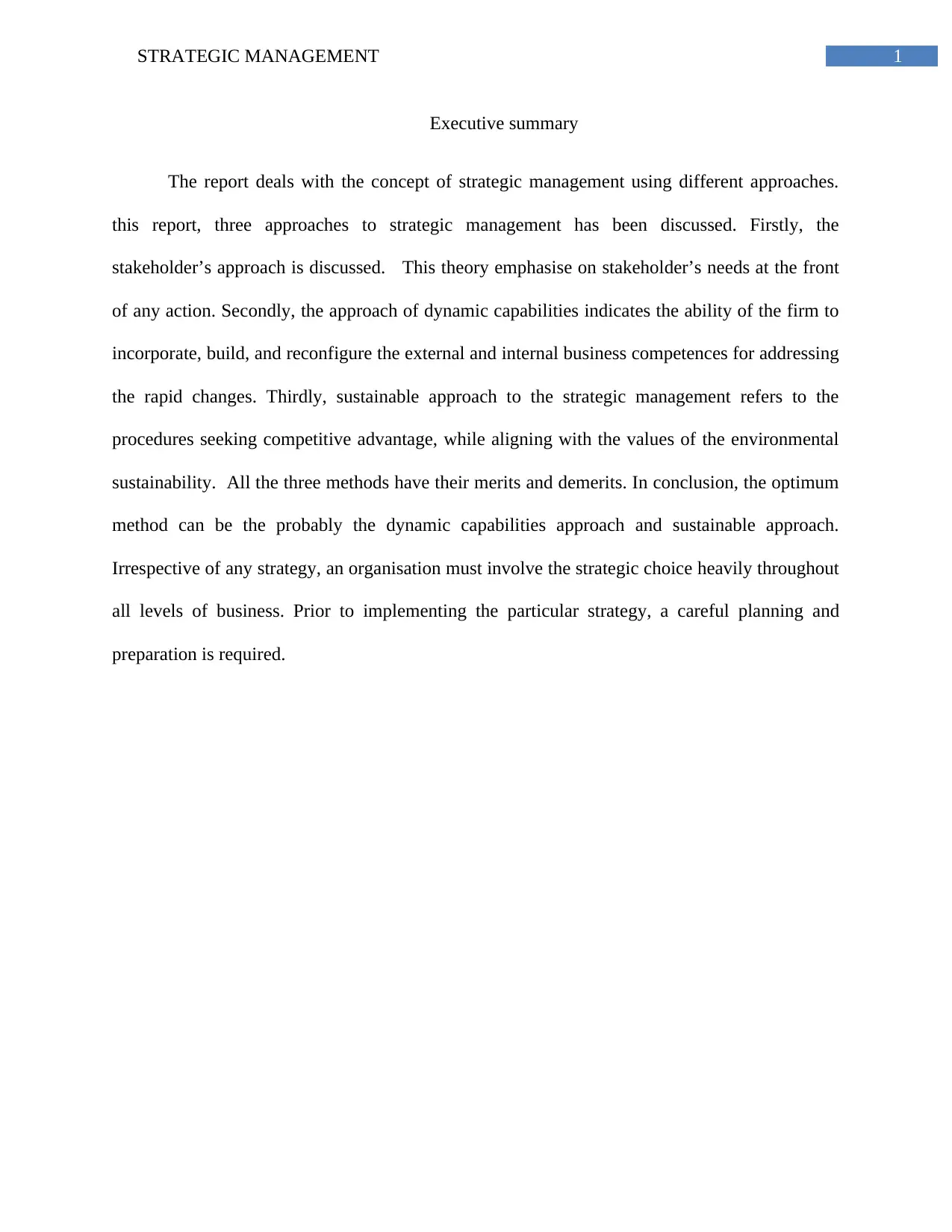
1STRATEGIC MANAGEMENT
Executive summary
The report deals with the concept of strategic management using different approaches.
this report, three approaches to strategic management has been discussed. Firstly, the
stakeholder’s approach is discussed. This theory emphasise on stakeholder’s needs at the front
of any action. Secondly, the approach of dynamic capabilities indicates the ability of the firm to
incorporate, build, and reconfigure the external and internal business competences for addressing
the rapid changes. Thirdly, sustainable approach to the strategic management refers to the
procedures seeking competitive advantage, while aligning with the values of the environmental
sustainability. All the three methods have their merits and demerits. In conclusion, the optimum
method can be the probably the dynamic capabilities approach and sustainable approach.
Irrespective of any strategy, an organisation must involve the strategic choice heavily throughout
all levels of business. Prior to implementing the particular strategy, a careful planning and
preparation is required.
Executive summary
The report deals with the concept of strategic management using different approaches.
this report, three approaches to strategic management has been discussed. Firstly, the
stakeholder’s approach is discussed. This theory emphasise on stakeholder’s needs at the front
of any action. Secondly, the approach of dynamic capabilities indicates the ability of the firm to
incorporate, build, and reconfigure the external and internal business competences for addressing
the rapid changes. Thirdly, sustainable approach to the strategic management refers to the
procedures seeking competitive advantage, while aligning with the values of the environmental
sustainability. All the three methods have their merits and demerits. In conclusion, the optimum
method can be the probably the dynamic capabilities approach and sustainable approach.
Irrespective of any strategy, an organisation must involve the strategic choice heavily throughout
all levels of business. Prior to implementing the particular strategy, a careful planning and
preparation is required.

2STRATEGIC MANAGEMENT
Table of Contents
Introduction..........................................................................................................................3
Approaches to strategic management..................................................................................4
Stakeholder approach...........................................................................................................4
Dynamic capabilities...........................................................................................................6
Sustainable approach...........................................................................................................8
Conclusion.........................................................................................................................10
Table of Contents
Introduction..........................................................................................................................3
Approaches to strategic management..................................................................................4
Stakeholder approach...........................................................................................................4
Dynamic capabilities...........................................................................................................6
Sustainable approach...........................................................................................................8
Conclusion.........................................................................................................................10
⊘ This is a preview!⊘
Do you want full access?
Subscribe today to unlock all pages.

Trusted by 1+ million students worldwide
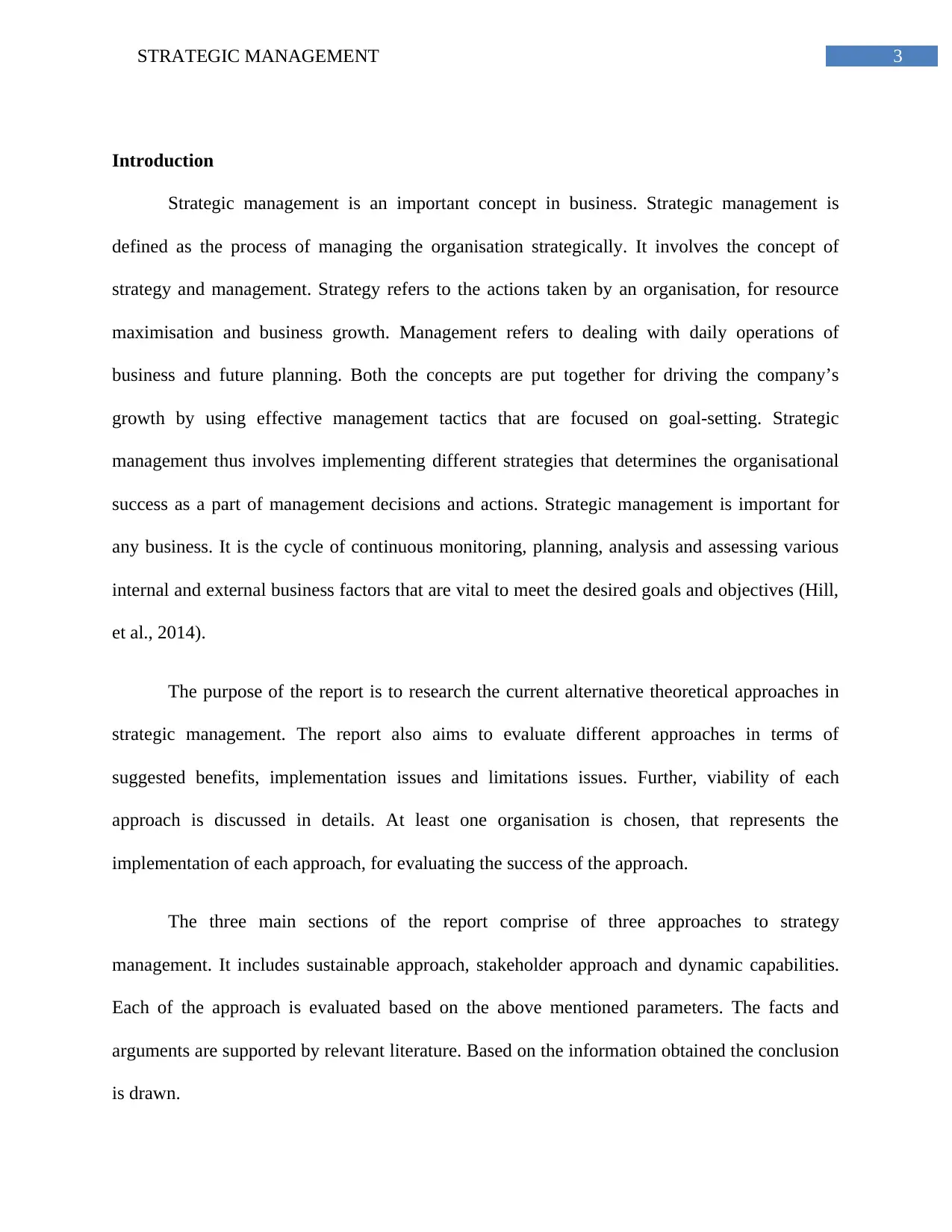
3STRATEGIC MANAGEMENT
Introduction
Strategic management is an important concept in business. Strategic management is
defined as the process of managing the organisation strategically. It involves the concept of
strategy and management. Strategy refers to the actions taken by an organisation, for resource
maximisation and business growth. Management refers to dealing with daily operations of
business and future planning. Both the concepts are put together for driving the company’s
growth by using effective management tactics that are focused on goal-setting. Strategic
management thus involves implementing different strategies that determines the organisational
success as a part of management decisions and actions. Strategic management is important for
any business. It is the cycle of continuous monitoring, planning, analysis and assessing various
internal and external business factors that are vital to meet the desired goals and objectives (Hill,
et al., 2014).
The purpose of the report is to research the current alternative theoretical approaches in
strategic management. The report also aims to evaluate different approaches in terms of
suggested benefits, implementation issues and limitations issues. Further, viability of each
approach is discussed in details. At least one organisation is chosen, that represents the
implementation of each approach, for evaluating the success of the approach.
The three main sections of the report comprise of three approaches to strategy
management. It includes sustainable approach, stakeholder approach and dynamic capabilities.
Each of the approach is evaluated based on the above mentioned parameters. The facts and
arguments are supported by relevant literature. Based on the information obtained the conclusion
is drawn.
Introduction
Strategic management is an important concept in business. Strategic management is
defined as the process of managing the organisation strategically. It involves the concept of
strategy and management. Strategy refers to the actions taken by an organisation, for resource
maximisation and business growth. Management refers to dealing with daily operations of
business and future planning. Both the concepts are put together for driving the company’s
growth by using effective management tactics that are focused on goal-setting. Strategic
management thus involves implementing different strategies that determines the organisational
success as a part of management decisions and actions. Strategic management is important for
any business. It is the cycle of continuous monitoring, planning, analysis and assessing various
internal and external business factors that are vital to meet the desired goals and objectives (Hill,
et al., 2014).
The purpose of the report is to research the current alternative theoretical approaches in
strategic management. The report also aims to evaluate different approaches in terms of
suggested benefits, implementation issues and limitations issues. Further, viability of each
approach is discussed in details. At least one organisation is chosen, that represents the
implementation of each approach, for evaluating the success of the approach.
The three main sections of the report comprise of three approaches to strategy
management. It includes sustainable approach, stakeholder approach and dynamic capabilities.
Each of the approach is evaluated based on the above mentioned parameters. The facts and
arguments are supported by relevant literature. Based on the information obtained the conclusion
is drawn.
Paraphrase This Document
Need a fresh take? Get an instant paraphrase of this document with our AI Paraphraser

4STRATEGIC MANAGEMENT
Approaches to strategic management
There are various approaches to the strategic management. In the section three
approaches are discussed.
Stakeholder approach
The stakeholder approach to the strategic management was first published in 1984 as a
part of “Pitman series in Business and Public Policy”. It is considered the landmark event in
development of “stakeholder theory” (Harrison, et al., 2015). This approach is based on the
principle of “what and who really counts”. This theory emphasise on the stakeholders as not just
the owners of the business but also the employees, suppliers, customers, government bodies,
trade associations and trade unions. The approach calls for putting stakeholder’s needs at the
front of any action. It means the strategic management process involves the managers to
formulate and execute strategies that will satisfy all the people who have stake in the business
(Bridoux and Stoelhorst, 2014).
The stakeholder approach seems viable. It was found to be successful when applied in
“Body Shop” (Luke, 2016). It was also demonstrated by Wal-Mart’s. The mangers of Wal-
Mart’s and Body Shop were found to develop collaborative relationships with the stakeholders
by developing strategy to balance the stakeholder’s interests. The organisation demonstrated the
practice of inclusion that is positively reinforced. It helps building the cooperative stakeholder
relationships. Using this approach it has been found easy to identify the interests of various
stakeholders, and analysing the conflicts of interest. This approach has helped the organisation
to increase the customer satisfaction. It has increased the profit level. In Wal-Mart’s it was found
Approaches to strategic management
There are various approaches to the strategic management. In the section three
approaches are discussed.
Stakeholder approach
The stakeholder approach to the strategic management was first published in 1984 as a
part of “Pitman series in Business and Public Policy”. It is considered the landmark event in
development of “stakeholder theory” (Harrison, et al., 2015). This approach is based on the
principle of “what and who really counts”. This theory emphasise on the stakeholders as not just
the owners of the business but also the employees, suppliers, customers, government bodies,
trade associations and trade unions. The approach calls for putting stakeholder’s needs at the
front of any action. It means the strategic management process involves the managers to
formulate and execute strategies that will satisfy all the people who have stake in the business
(Bridoux and Stoelhorst, 2014).
The stakeholder approach seems viable. It was found to be successful when applied in
“Body Shop” (Luke, 2016). It was also demonstrated by Wal-Mart’s. The mangers of Wal-
Mart’s and Body Shop were found to develop collaborative relationships with the stakeholders
by developing strategy to balance the stakeholder’s interests. The organisation demonstrated the
practice of inclusion that is positively reinforced. It helps building the cooperative stakeholder
relationships. Using this approach it has been found easy to identify the interests of various
stakeholders, and analysing the conflicts of interest. This approach has helped the organisation
to increase the customer satisfaction. It has increased the profit level. In Wal-Mart’s it was found
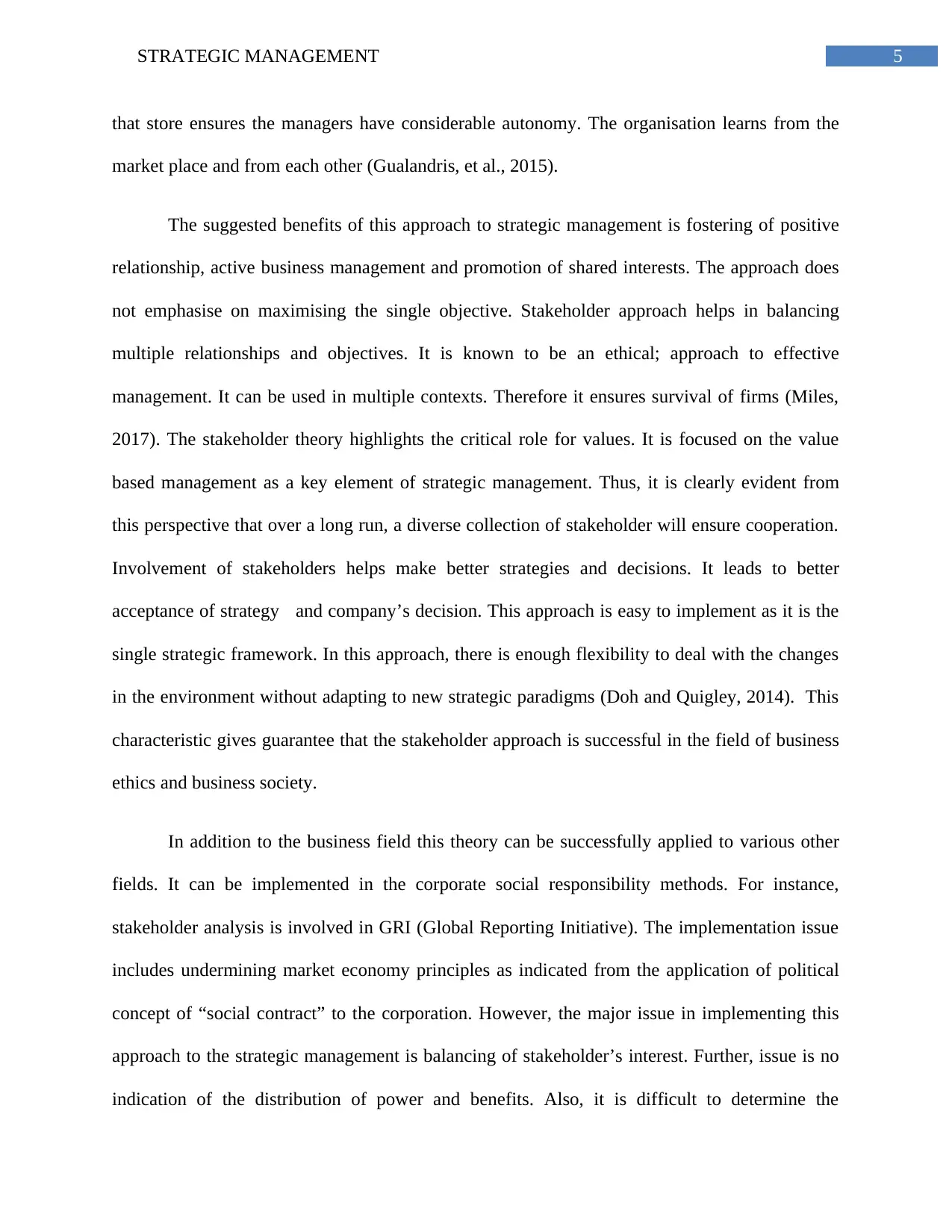
5STRATEGIC MANAGEMENT
that store ensures the managers have considerable autonomy. The organisation learns from the
market place and from each other (Gualandris, et al., 2015).
The suggested benefits of this approach to strategic management is fostering of positive
relationship, active business management and promotion of shared interests. The approach does
not emphasise on maximising the single objective. Stakeholder approach helps in balancing
multiple relationships and objectives. It is known to be an ethical; approach to effective
management. It can be used in multiple contexts. Therefore it ensures survival of firms (Miles,
2017). The stakeholder theory highlights the critical role for values. It is focused on the value
based management as a key element of strategic management. Thus, it is clearly evident from
this perspective that over a long run, a diverse collection of stakeholder will ensure cooperation.
Involvement of stakeholders helps make better strategies and decisions. It leads to better
acceptance of strategy and company’s decision. This approach is easy to implement as it is the
single strategic framework. In this approach, there is enough flexibility to deal with the changes
in the environment without adapting to new strategic paradigms (Doh and Quigley, 2014). This
characteristic gives guarantee that the stakeholder approach is successful in the field of business
ethics and business society.
In addition to the business field this theory can be successfully applied to various other
fields. It can be implemented in the corporate social responsibility methods. For instance,
stakeholder analysis is involved in GRI (Global Reporting Initiative). The implementation issue
includes undermining market economy principles as indicated from the application of political
concept of “social contract” to the corporation. However, the major issue in implementing this
approach to the strategic management is balancing of stakeholder’s interest. Further, issue is no
indication of the distribution of power and benefits. Also, it is difficult to determine the
that store ensures the managers have considerable autonomy. The organisation learns from the
market place and from each other (Gualandris, et al., 2015).
The suggested benefits of this approach to strategic management is fostering of positive
relationship, active business management and promotion of shared interests. The approach does
not emphasise on maximising the single objective. Stakeholder approach helps in balancing
multiple relationships and objectives. It is known to be an ethical; approach to effective
management. It can be used in multiple contexts. Therefore it ensures survival of firms (Miles,
2017). The stakeholder theory highlights the critical role for values. It is focused on the value
based management as a key element of strategic management. Thus, it is clearly evident from
this perspective that over a long run, a diverse collection of stakeholder will ensure cooperation.
Involvement of stakeholders helps make better strategies and decisions. It leads to better
acceptance of strategy and company’s decision. This approach is easy to implement as it is the
single strategic framework. In this approach, there is enough flexibility to deal with the changes
in the environment without adapting to new strategic paradigms (Doh and Quigley, 2014). This
characteristic gives guarantee that the stakeholder approach is successful in the field of business
ethics and business society.
In addition to the business field this theory can be successfully applied to various other
fields. It can be implemented in the corporate social responsibility methods. For instance,
stakeholder analysis is involved in GRI (Global Reporting Initiative). The implementation issue
includes undermining market economy principles as indicated from the application of political
concept of “social contract” to the corporation. However, the major issue in implementing this
approach to the strategic management is balancing of stakeholder’s interest. Further, issue is no
indication of the distribution of power and benefits. Also, it is difficult to determine the
⊘ This is a preview!⊘
Do you want full access?
Subscribe today to unlock all pages.

Trusted by 1+ million students worldwide

6STRATEGIC MANAGEMENT
stakeholder group’s mutual rights and obligations. It is impossible to measure the stakes (Mason
and Simmons, 2014).
There are limitations to this approach in strategic management. A firm must regularly
engage in stakeholder analysis. As there is rapid change in the associations, and power of the
stakeholder, regular analysis is the time consuming process. It can be argued that the action of an
organisation towards its stakeholders will ultimately depend on the subjective perception of the
management. The limitation of the approach comes from the fact that the managers have to
regularly asses the position of each stakeholder. It is not feasible for the management to satisfy
all the stakeholders. Fulfilling the demands of all the stakeholders is not a completely achievable
task (Moura-Leite, et al., 2014). Sometimes the cooperation of the stakeholder is missing. This
approach can be successful only when the management of the organisation focuses on leading
stakeholder group, while satisfying others as much possible. Alternately, the management can
reconcile all interests as per urgency or importance.
Dynamic capabilities
The concept of dynamic capabilities was published in the paper, “Dynamic Capabilities
and Strategic Management”, in 1997. It was defined by Teece Pisano & Shuen, (1999). The term
indicate the firm’s ability to incorporate, build, and reconfigure the external and internal business
competences for addressing the rapid changes. In this process the four dynamic capabilities
include “adding, transferring, integrating and shedding”. The term dynamic means to renew the
existing competences in accordance with the changes in business environment (Sune and Gibb,
2015). The key role of the strategic management is emphasised by the term “capabilities” which
means adaptation and reconfiguration of the competencies or skills resources to match the
stakeholder group’s mutual rights and obligations. It is impossible to measure the stakes (Mason
and Simmons, 2014).
There are limitations to this approach in strategic management. A firm must regularly
engage in stakeholder analysis. As there is rapid change in the associations, and power of the
stakeholder, regular analysis is the time consuming process. It can be argued that the action of an
organisation towards its stakeholders will ultimately depend on the subjective perception of the
management. The limitation of the approach comes from the fact that the managers have to
regularly asses the position of each stakeholder. It is not feasible for the management to satisfy
all the stakeholders. Fulfilling the demands of all the stakeholders is not a completely achievable
task (Moura-Leite, et al., 2014). Sometimes the cooperation of the stakeholder is missing. This
approach can be successful only when the management of the organisation focuses on leading
stakeholder group, while satisfying others as much possible. Alternately, the management can
reconcile all interests as per urgency or importance.
Dynamic capabilities
The concept of dynamic capabilities was published in the paper, “Dynamic Capabilities
and Strategic Management”, in 1997. It was defined by Teece Pisano & Shuen, (1999). The term
indicate the firm’s ability to incorporate, build, and reconfigure the external and internal business
competences for addressing the rapid changes. In this process the four dynamic capabilities
include “adding, transferring, integrating and shedding”. The term dynamic means to renew the
existing competences in accordance with the changes in business environment (Sune and Gibb,
2015). The key role of the strategic management is emphasised by the term “capabilities” which
means adaptation and reconfiguration of the competencies or skills resources to match the
Paraphrase This Document
Need a fresh take? Get an instant paraphrase of this document with our AI Paraphraser
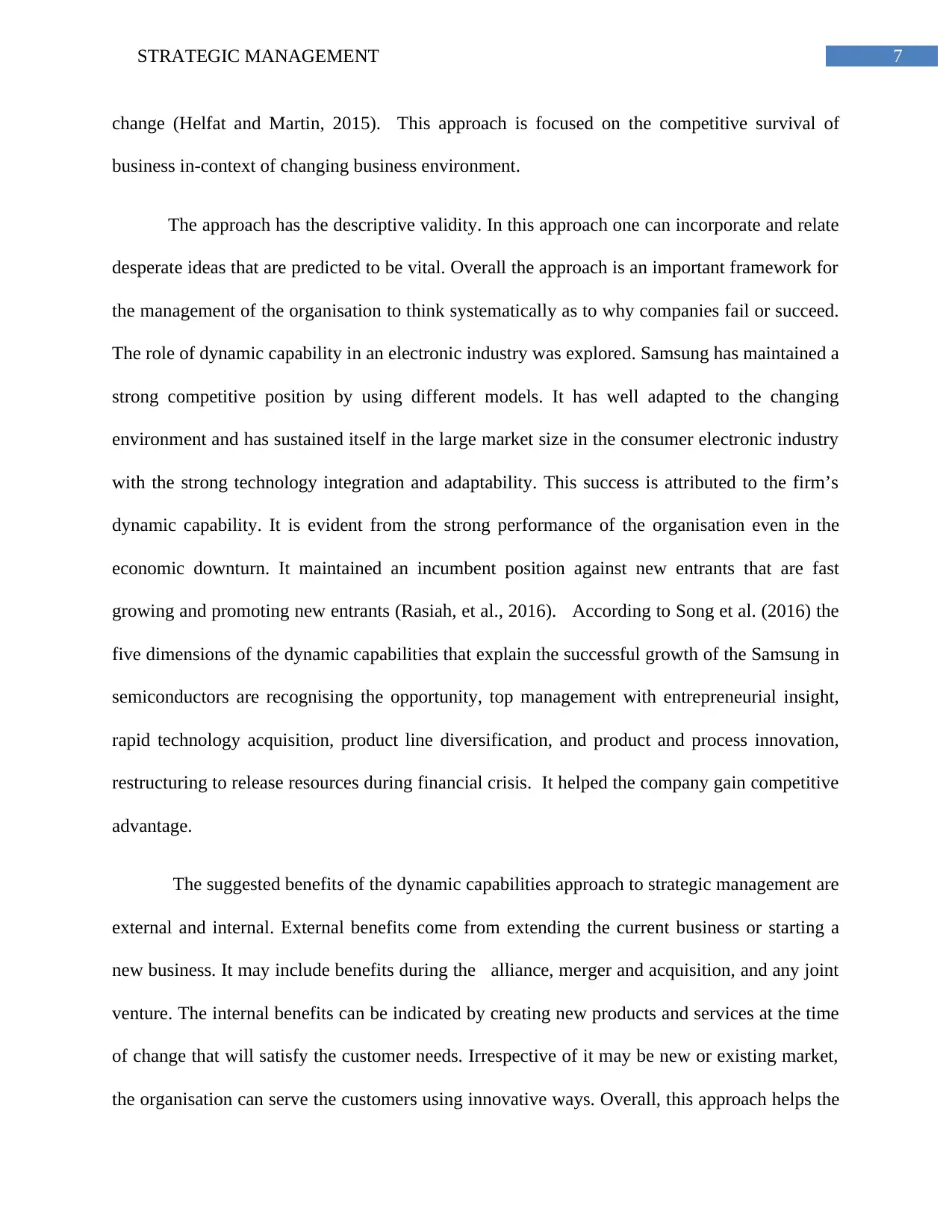
7STRATEGIC MANAGEMENT
change (Helfat and Martin, 2015). This approach is focused on the competitive survival of
business in-context of changing business environment.
The approach has the descriptive validity. In this approach one can incorporate and relate
desperate ideas that are predicted to be vital. Overall the approach is an important framework for
the management of the organisation to think systematically as to why companies fail or succeed.
The role of dynamic capability in an electronic industry was explored. Samsung has maintained a
strong competitive position by using different models. It has well adapted to the changing
environment and has sustained itself in the large market size in the consumer electronic industry
with the strong technology integration and adaptability. This success is attributed to the firm’s
dynamic capability. It is evident from the strong performance of the organisation even in the
economic downturn. It maintained an incumbent position against new entrants that are fast
growing and promoting new entrants (Rasiah, et al., 2016). According to Song et al. (2016) the
five dimensions of the dynamic capabilities that explain the successful growth of the Samsung in
semiconductors are recognising the opportunity, top management with entrepreneurial insight,
rapid technology acquisition, product line diversification, and product and process innovation,
restructuring to release resources during financial crisis. It helped the company gain competitive
advantage.
The suggested benefits of the dynamic capabilities approach to strategic management are
external and internal. External benefits come from extending the current business or starting a
new business. It may include benefits during the alliance, merger and acquisition, and any joint
venture. The internal benefits can be indicated by creating new products and services at the time
of change that will satisfy the customer needs. Irrespective of it may be new or existing market,
the organisation can serve the customers using innovative ways. Overall, this approach helps the
change (Helfat and Martin, 2015). This approach is focused on the competitive survival of
business in-context of changing business environment.
The approach has the descriptive validity. In this approach one can incorporate and relate
desperate ideas that are predicted to be vital. Overall the approach is an important framework for
the management of the organisation to think systematically as to why companies fail or succeed.
The role of dynamic capability in an electronic industry was explored. Samsung has maintained a
strong competitive position by using different models. It has well adapted to the changing
environment and has sustained itself in the large market size in the consumer electronic industry
with the strong technology integration and adaptability. This success is attributed to the firm’s
dynamic capability. It is evident from the strong performance of the organisation even in the
economic downturn. It maintained an incumbent position against new entrants that are fast
growing and promoting new entrants (Rasiah, et al., 2016). According to Song et al. (2016) the
five dimensions of the dynamic capabilities that explain the successful growth of the Samsung in
semiconductors are recognising the opportunity, top management with entrepreneurial insight,
rapid technology acquisition, product line diversification, and product and process innovation,
restructuring to release resources during financial crisis. It helped the company gain competitive
advantage.
The suggested benefits of the dynamic capabilities approach to strategic management are
external and internal. External benefits come from extending the current business or starting a
new business. It may include benefits during the alliance, merger and acquisition, and any joint
venture. The internal benefits can be indicated by creating new products and services at the time
of change that will satisfy the customer needs. Irrespective of it may be new or existing market,
the organisation can serve the customers using innovative ways. Overall, this approach helps the
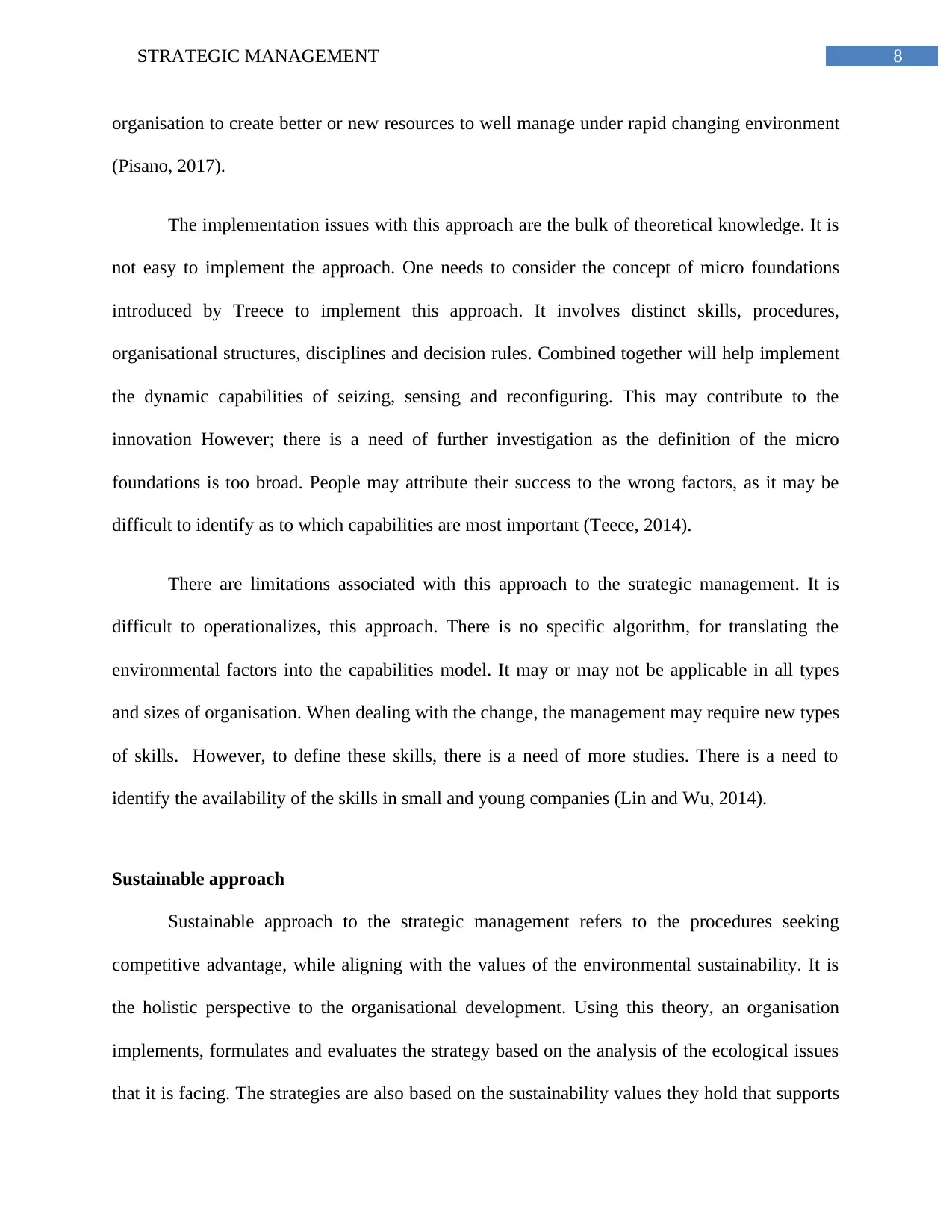
8STRATEGIC MANAGEMENT
organisation to create better or new resources to well manage under rapid changing environment
(Pisano, 2017).
The implementation issues with this approach are the bulk of theoretical knowledge. It is
not easy to implement the approach. One needs to consider the concept of micro foundations
introduced by Treece to implement this approach. It involves distinct skills, procedures,
organisational structures, disciplines and decision rules. Combined together will help implement
the dynamic capabilities of seizing, sensing and reconfiguring. This may contribute to the
innovation However; there is a need of further investigation as the definition of the micro
foundations is too broad. People may attribute their success to the wrong factors, as it may be
difficult to identify as to which capabilities are most important (Teece, 2014).
There are limitations associated with this approach to the strategic management. It is
difficult to operationalizes, this approach. There is no specific algorithm, for translating the
environmental factors into the capabilities model. It may or may not be applicable in all types
and sizes of organisation. When dealing with the change, the management may require new types
of skills. However, to define these skills, there is a need of more studies. There is a need to
identify the availability of the skills in small and young companies (Lin and Wu, 2014).
Sustainable approach
Sustainable approach to the strategic management refers to the procedures seeking
competitive advantage, while aligning with the values of the environmental sustainability. It is
the holistic perspective to the organisational development. Using this theory, an organisation
implements, formulates and evaluates the strategy based on the analysis of the ecological issues
that it is facing. The strategies are also based on the sustainability values they hold that supports
organisation to create better or new resources to well manage under rapid changing environment
(Pisano, 2017).
The implementation issues with this approach are the bulk of theoretical knowledge. It is
not easy to implement the approach. One needs to consider the concept of micro foundations
introduced by Treece to implement this approach. It involves distinct skills, procedures,
organisational structures, disciplines and decision rules. Combined together will help implement
the dynamic capabilities of seizing, sensing and reconfiguring. This may contribute to the
innovation However; there is a need of further investigation as the definition of the micro
foundations is too broad. People may attribute their success to the wrong factors, as it may be
difficult to identify as to which capabilities are most important (Teece, 2014).
There are limitations associated with this approach to the strategic management. It is
difficult to operationalizes, this approach. There is no specific algorithm, for translating the
environmental factors into the capabilities model. It may or may not be applicable in all types
and sizes of organisation. When dealing with the change, the management may require new types
of skills. However, to define these skills, there is a need of more studies. There is a need to
identify the availability of the skills in small and young companies (Lin and Wu, 2014).
Sustainable approach
Sustainable approach to the strategic management refers to the procedures seeking
competitive advantage, while aligning with the values of the environmental sustainability. It is
the holistic perspective to the organisational development. Using this theory, an organisation
implements, formulates and evaluates the strategy based on the analysis of the ecological issues
that it is facing. The strategies are also based on the sustainability values they hold that supports
⊘ This is a preview!⊘
Do you want full access?
Subscribe today to unlock all pages.

Trusted by 1+ million students worldwide
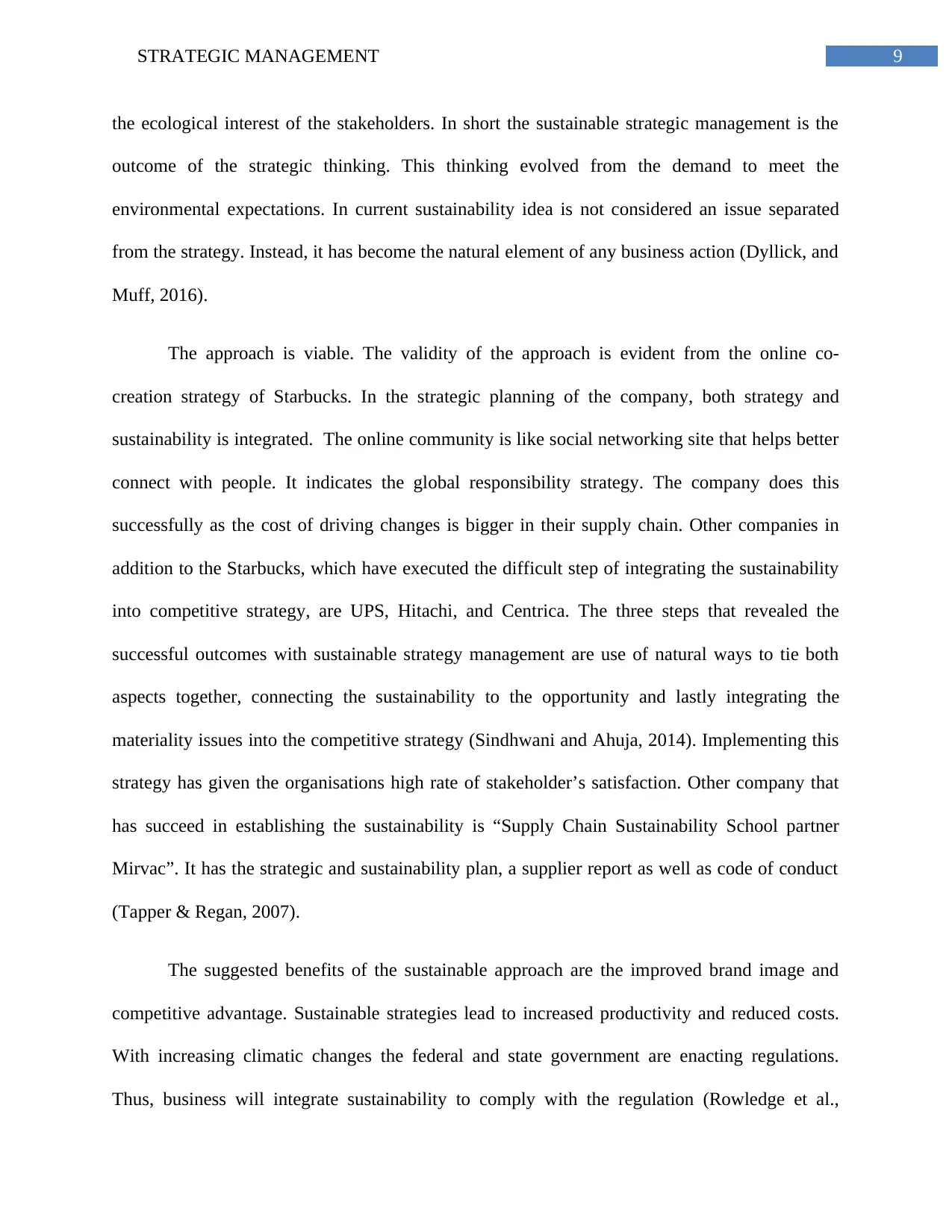
9STRATEGIC MANAGEMENT
the ecological interest of the stakeholders. In short the sustainable strategic management is the
outcome of the strategic thinking. This thinking evolved from the demand to meet the
environmental expectations. In current sustainability idea is not considered an issue separated
from the strategy. Instead, it has become the natural element of any business action (Dyllick, and
Muff, 2016).
The approach is viable. The validity of the approach is evident from the online co-
creation strategy of Starbucks. In the strategic planning of the company, both strategy and
sustainability is integrated. The online community is like social networking site that helps better
connect with people. It indicates the global responsibility strategy. The company does this
successfully as the cost of driving changes is bigger in their supply chain. Other companies in
addition to the Starbucks, which have executed the difficult step of integrating the sustainability
into competitive strategy, are UPS, Hitachi, and Centrica. The three steps that revealed the
successful outcomes with sustainable strategy management are use of natural ways to tie both
aspects together, connecting the sustainability to the opportunity and lastly integrating the
materiality issues into the competitive strategy (Sindhwani and Ahuja, 2014). Implementing this
strategy has given the organisations high rate of stakeholder’s satisfaction. Other company that
has succeed in establishing the sustainability is “Supply Chain Sustainability School partner
Mirvac”. It has the strategic and sustainability plan, a supplier report as well as code of conduct
(Tapper & Regan, 2007).
The suggested benefits of the sustainable approach are the improved brand image and
competitive advantage. Sustainable strategies lead to increased productivity and reduced costs.
With increasing climatic changes the federal and state government are enacting regulations.
Thus, business will integrate sustainability to comply with the regulation (Rowledge et al.,
the ecological interest of the stakeholders. In short the sustainable strategic management is the
outcome of the strategic thinking. This thinking evolved from the demand to meet the
environmental expectations. In current sustainability idea is not considered an issue separated
from the strategy. Instead, it has become the natural element of any business action (Dyllick, and
Muff, 2016).
The approach is viable. The validity of the approach is evident from the online co-
creation strategy of Starbucks. In the strategic planning of the company, both strategy and
sustainability is integrated. The online community is like social networking site that helps better
connect with people. It indicates the global responsibility strategy. The company does this
successfully as the cost of driving changes is bigger in their supply chain. Other companies in
addition to the Starbucks, which have executed the difficult step of integrating the sustainability
into competitive strategy, are UPS, Hitachi, and Centrica. The three steps that revealed the
successful outcomes with sustainable strategy management are use of natural ways to tie both
aspects together, connecting the sustainability to the opportunity and lastly integrating the
materiality issues into the competitive strategy (Sindhwani and Ahuja, 2014). Implementing this
strategy has given the organisations high rate of stakeholder’s satisfaction. Other company that
has succeed in establishing the sustainability is “Supply Chain Sustainability School partner
Mirvac”. It has the strategic and sustainability plan, a supplier report as well as code of conduct
(Tapper & Regan, 2007).
The suggested benefits of the sustainable approach are the improved brand image and
competitive advantage. Sustainable strategies lead to increased productivity and reduced costs.
With increasing climatic changes the federal and state government are enacting regulations.
Thus, business will integrate sustainability to comply with the regulation (Rowledge et al.,
Paraphrase This Document
Need a fresh take? Get an instant paraphrase of this document with our AI Paraphraser
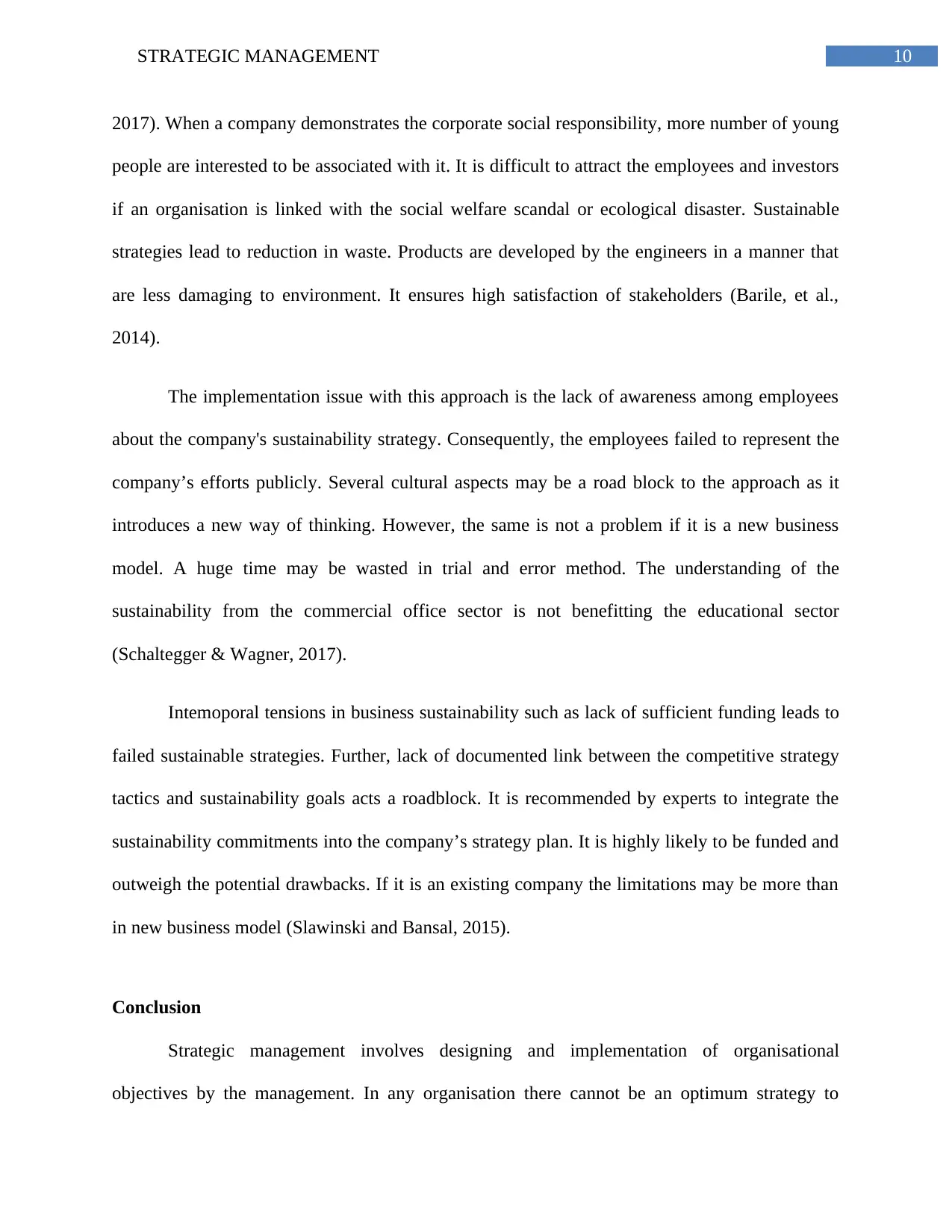
10STRATEGIC MANAGEMENT
2017). When a company demonstrates the corporate social responsibility, more number of young
people are interested to be associated with it. It is difficult to attract the employees and investors
if an organisation is linked with the social welfare scandal or ecological disaster. Sustainable
strategies lead to reduction in waste. Products are developed by the engineers in a manner that
are less damaging to environment. It ensures high satisfaction of stakeholders (Barile, et al.,
2014).
The implementation issue with this approach is the lack of awareness among employees
about the company's sustainability strategy. Consequently, the employees failed to represent the
company’s efforts publicly. Several cultural aspects may be a road block to the approach as it
introduces a new way of thinking. However, the same is not a problem if it is a new business
model. A huge time may be wasted in trial and error method. The understanding of the
sustainability from the commercial office sector is not benefitting the educational sector
(Schaltegger & Wagner, 2017).
Intemoporal tensions in business sustainability such as lack of sufficient funding leads to
failed sustainable strategies. Further, lack of documented link between the competitive strategy
tactics and sustainability goals acts a roadblock. It is recommended by experts to integrate the
sustainability commitments into the company’s strategy plan. It is highly likely to be funded and
outweigh the potential drawbacks. If it is an existing company the limitations may be more than
in new business model (Slawinski and Bansal, 2015).
Conclusion
Strategic management involves designing and implementation of organisational
objectives by the management. In any organisation there cannot be an optimum strategy to
2017). When a company demonstrates the corporate social responsibility, more number of young
people are interested to be associated with it. It is difficult to attract the employees and investors
if an organisation is linked with the social welfare scandal or ecological disaster. Sustainable
strategies lead to reduction in waste. Products are developed by the engineers in a manner that
are less damaging to environment. It ensures high satisfaction of stakeholders (Barile, et al.,
2014).
The implementation issue with this approach is the lack of awareness among employees
about the company's sustainability strategy. Consequently, the employees failed to represent the
company’s efforts publicly. Several cultural aspects may be a road block to the approach as it
introduces a new way of thinking. However, the same is not a problem if it is a new business
model. A huge time may be wasted in trial and error method. The understanding of the
sustainability from the commercial office sector is not benefitting the educational sector
(Schaltegger & Wagner, 2017).
Intemoporal tensions in business sustainability such as lack of sufficient funding leads to
failed sustainable strategies. Further, lack of documented link between the competitive strategy
tactics and sustainability goals acts a roadblock. It is recommended by experts to integrate the
sustainability commitments into the company’s strategy plan. It is highly likely to be funded and
outweigh the potential drawbacks. If it is an existing company the limitations may be more than
in new business model (Slawinski and Bansal, 2015).
Conclusion
Strategic management involves designing and implementation of organisational
objectives by the management. In any organisation there cannot be an optimum strategy to
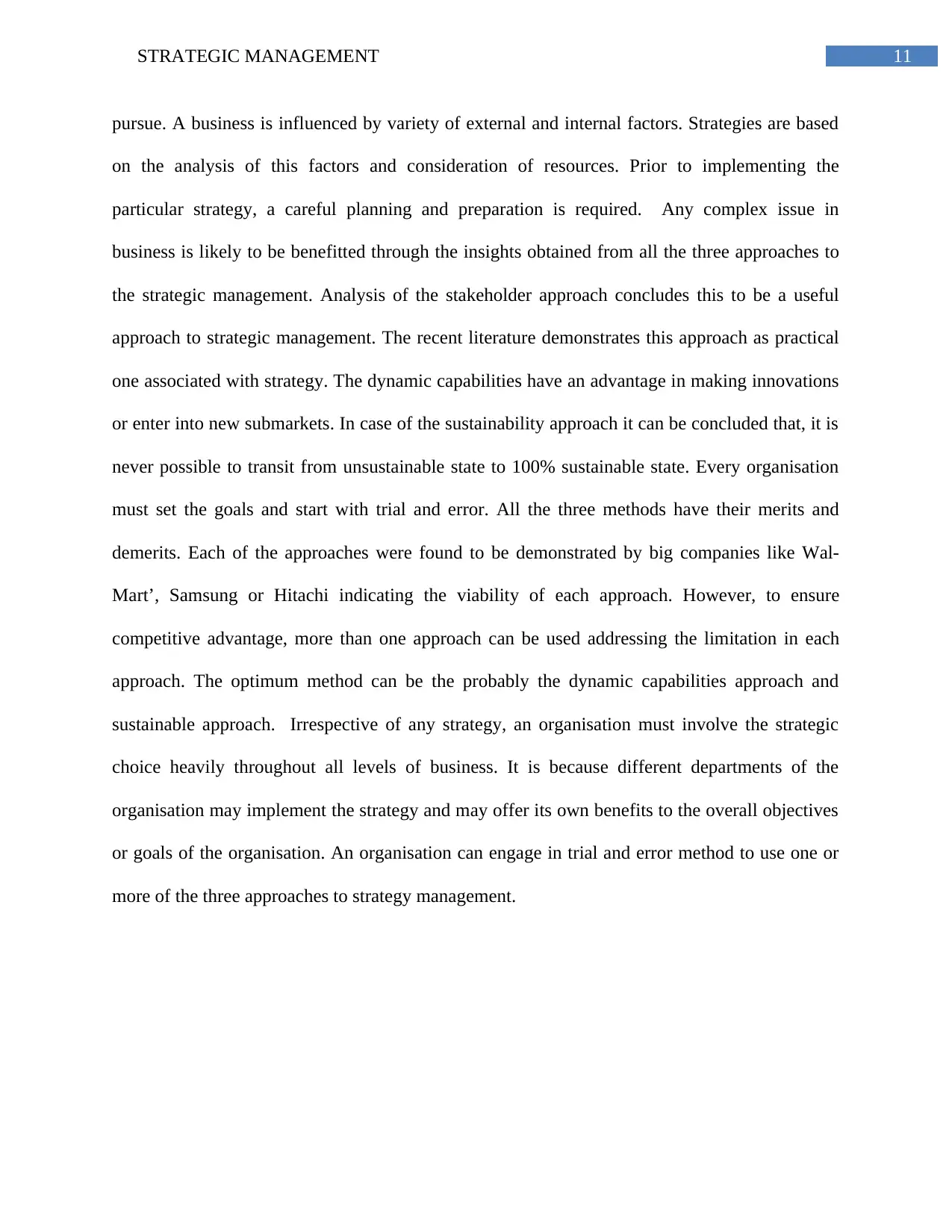
11STRATEGIC MANAGEMENT
pursue. A business is influenced by variety of external and internal factors. Strategies are based
on the analysis of this factors and consideration of resources. Prior to implementing the
particular strategy, a careful planning and preparation is required. Any complex issue in
business is likely to be benefitted through the insights obtained from all the three approaches to
the strategic management. Analysis of the stakeholder approach concludes this to be a useful
approach to strategic management. The recent literature demonstrates this approach as practical
one associated with strategy. The dynamic capabilities have an advantage in making innovations
or enter into new submarkets. In case of the sustainability approach it can be concluded that, it is
never possible to transit from unsustainable state to 100% sustainable state. Every organisation
must set the goals and start with trial and error. All the three methods have their merits and
demerits. Each of the approaches were found to be demonstrated by big companies like Wal-
Mart’, Samsung or Hitachi indicating the viability of each approach. However, to ensure
competitive advantage, more than one approach can be used addressing the limitation in each
approach. The optimum method can be the probably the dynamic capabilities approach and
sustainable approach. Irrespective of any strategy, an organisation must involve the strategic
choice heavily throughout all levels of business. It is because different departments of the
organisation may implement the strategy and may offer its own benefits to the overall objectives
or goals of the organisation. An organisation can engage in trial and error method to use one or
more of the three approaches to strategy management.
pursue. A business is influenced by variety of external and internal factors. Strategies are based
on the analysis of this factors and consideration of resources. Prior to implementing the
particular strategy, a careful planning and preparation is required. Any complex issue in
business is likely to be benefitted through the insights obtained from all the three approaches to
the strategic management. Analysis of the stakeholder approach concludes this to be a useful
approach to strategic management. The recent literature demonstrates this approach as practical
one associated with strategy. The dynamic capabilities have an advantage in making innovations
or enter into new submarkets. In case of the sustainability approach it can be concluded that, it is
never possible to transit from unsustainable state to 100% sustainable state. Every organisation
must set the goals and start with trial and error. All the three methods have their merits and
demerits. Each of the approaches were found to be demonstrated by big companies like Wal-
Mart’, Samsung or Hitachi indicating the viability of each approach. However, to ensure
competitive advantage, more than one approach can be used addressing the limitation in each
approach. The optimum method can be the probably the dynamic capabilities approach and
sustainable approach. Irrespective of any strategy, an organisation must involve the strategic
choice heavily throughout all levels of business. It is because different departments of the
organisation may implement the strategy and may offer its own benefits to the overall objectives
or goals of the organisation. An organisation can engage in trial and error method to use one or
more of the three approaches to strategy management.
⊘ This is a preview!⊘
Do you want full access?
Subscribe today to unlock all pages.

Trusted by 1+ million students worldwide
1 out of 17
Related Documents
Your All-in-One AI-Powered Toolkit for Academic Success.
+13062052269
info@desklib.com
Available 24*7 on WhatsApp / Email
![[object Object]](/_next/static/media/star-bottom.7253800d.svg)
Unlock your academic potential
Copyright © 2020–2025 A2Z Services. All Rights Reserved. Developed and managed by ZUCOL.




